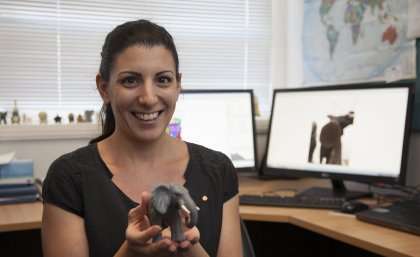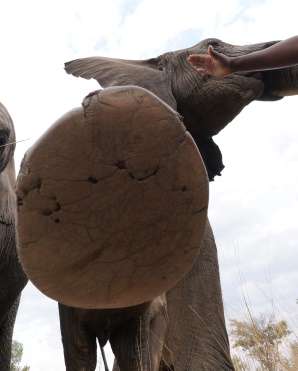Scientist pursues the perfect pachyderm pedicure

Finding the best method of trimming the feet of captive elephants is the focus of a University of Queensland study to help prevent painful and untreatable foot diseases.
Captive elephants' feet are routinely trimmed to counter the effects of walking on unnatural ground in restricted spaces.
Their wild counterparts benefit from 'natural pedicures' from walking long distances on various surfaces and rubbing their feet in dirt.
Dr Olga Panagiotopoulou, from UQ's School of Biomedical Sciences, is working with collaborators around the world to understand how captivity influences elephant foot form and function and to identify the best method of preventative foot trimming.
"Elephants are the largest terrestrial mammals alive today and can weigh up to eight tonnes, with their whole body mass supported by their tiny feet," Dr Panagiotopoulou said.
"We know that when these large animals walk, a huge amount of pressure is applied to their feet.
"Preliminary data has indicated that foot pressure is more evenly distributed across the sole of the foot when the animals walk on natural grounds, but when they are walking on surfaces such as concrete the pressure is concentrated around parts of the foot that are more prone to disease, such as the lateral toes."
Dr Panagiotopoulou said a range of foot-trimming protocols were followed but none had been tested.
"Our research involves testing different techniques to see which one will be most beneficial for the animal."
In collaboration with Germany-based company Zebris Biomechanix, Dr Panagiotopoulou has developed pressure platforms to dynamically measure the pressure and forces applied to elephants' feet while walking.
"The plates were recently transported to the Adventures with Elephants safari park in South Africa to study the foot pressures of elephants kept in semi-wild conditions with natural terrains," she said.

"The elephants were trained to walk over the pressure platforms and the individual footsteps were processed using a state-of-the-art neuroimaging technique called statistical parametric mapping, which, in simple words, gives us a high-resolution image of foot pressure changes over the foot.
"We hope to develop smaller versions of these pressure platforms for zoo keepers and managers to use as diagnostic tools.
"If a captive elephant walks over a pad and a different digital pressure pattern from normal is seen, this can be investigated further."
Dr Panagiotopoulou said early diagnosis was important because elephant foot diseases such as osteoarthritis and osteomyelitis were often diagnosed too late for treatment, meaning the elephants had to be euthanised.
"Our research is focussed on developing diagnostic approaches to prevent this from happening and we have received huge support from captive enclosures in Australia and around the world."
Provided by University of Queensland




















